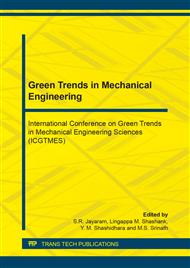p.122
p.127
p.134
p.139
p.144
p.152
p.158
p.164
p.170
Estimation and Comparison of Electrode Wear and Ae Parameters of Titanium Material in Wire Electric Discharge Machining Using ANN
Abstract:
Wire Electrical Discharge Machining (WEDM) is a specialized thermal machining process capable of accurately machining parts with varying hardness or complex shapes, which have sharp edges that are very difficult to be machined by the main stream machining processes. Selection of process parameters for obtaining higher cutting efficiency or accuracy in WEDM is still not fully solved, even with most up-to-date CNC wire EDM machine. It is widely recognised that Acoustic Emission (AE) is gaining ground as a monitoring method for health diagnosis on rotating machinery. The advantage of AE monitoring over vibration monitoring is that the AE monitoring can detect the growth of subsurface cracks whereas the vibration monitoring can detect defects only when they appear on the surface. This study outlines the optimization of titanium material using L16 design of experiment. Each experiment has been performed varying the process parameters like pulse-on time, pulse-off time, current and bed speed. Among different process parameters voltage and flush rate were kept constant. Molybdenum wire having diameter of 0.18 mm was used as an electrode. Simple functional relationships between the parameters were plotted to arrive at possible information on Electrode Wear (EW) and AE signals. But these simpler methods of analysis did not provide any information about the status of the electrode. Thus, there is a requirement for more sophisticated methods that are capable of integrating information from the multiple sensors. Hence, method like Artificial Neural Network (ANN) has been applied for the estimation of EW, AE signal strength, AE count and AE RMS. The ANN algorithm is designed to learn the process by training the algorithm with the experimental data. The experimental observations are divided into three sets: the training set, validation set and testing set. The training set is used to make the ANN learn the process and the testing set will check the performance of ANN. Different models can be obtained by varying the percentage of data in the training set and the best model can be selected from these, viz., 50%, 60% and 70%. The best model is selected from the said percentages of data. Estimation of the EW and AE signals parameters by ANN at 70% of data training set showed the best correlation with the measured value.
Info:
Periodical:
Pages:
144-151
Citation:
Online since:
November 2019
Authors:
Keywords:
Price:
Сopyright:
© 2019 Trans Tech Publications Ltd. All Rights Reserved
Share:
Citation:


